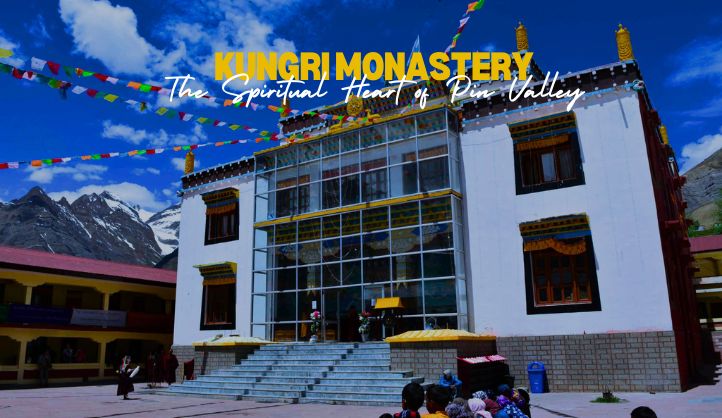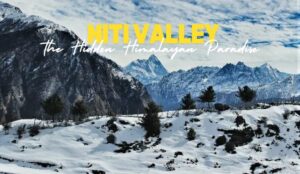In the serene and remote Pin Valley of Himachal Pradesh, Kungri Monastery is a sacred Buddhist site that stands as a testament to the spiritual and cultural richness of the Spiti region. Founded in the 14th century, it is the second-oldest monastery in Spiti after Tabo Monastery and is a beacon of the ancient Nyingmapa sect of Tibetan Buddhism. Kungri Monastery, with its centuries-old murals, rituals, and serene ambiance, offers visitors an intimate glimpse into the spiritual essence of the Himalayas.
Historical Background
Kungri Monastery’s origins trace back to the Nyingmapa school of Tibetan Buddhism, one of the oldest sects of Buddhism, established by Guru Padmasambhava. The monastery was constructed in the 14th century and has since been a significant spiritual hub for the region. Despite the passage of time, Kungri has preserved its traditions and continues to serve as a center for meditation, learning, and community gatherings.
The monastery’s significance extends beyond religious boundaries; it has been instrumental in preserving the cultural identity of the Pin Valley, where Buddhism deeply influences daily life.
Architecture and Layout
Kungri Monastery’s architecture is a blend of simplicity and traditional Tibetan Buddhist design. It consists of three main rectangular buildings, each adorned with vibrant murals and Thangka paintings that narrate Buddhist scriptures and tales.
Key Features:
- Prayer Halls:
The prayer halls are adorned with large silk Thangkas, wall paintings of deities, and intricate carvings. The halls resonate with the chants of monks, offering a serene ambiance for meditation. - Buddhist Scriptures and Relics:
The monastery houses rare manuscripts and artifacts, including ancient Tibetan Buddhist texts, ritual items, and relics that showcase the rich spiritual heritage of the region. - Chortens:
Surrounding the monastery are several stupas or chortens, which symbolize enlightenment and are considered sacred by devotees. - Unique Wind-Chime Effect:
The monastery’s strategic location in Pin Valley creates a natural wind-chime effect as the wind whistles through the structures, adding a mystical charm.
Spiritual Practices
Kungri Monastery remains a center of spiritual learning and practice. The monks here follow the Nyingmapa traditions, emphasizing meditation, chanting, and tantric rituals.
Meditation and Retreats:
The serene surroundings of Pin Valley make Kungri an ideal location for meditation. Many monks and practitioners come here for long-term retreats, immersing themselves in spiritual practices.
Ritual Ceremonies:
Kungri is known for its elaborate rituals, including:
- Butter Lamp Offerings: A daily ritual symbolizing the dispelling of darkness and ignorance.
- Chham Dances: Performed during festivals, these dances depict Buddhist teachings and stories through vibrant costumes and masks.
Festivals and Celebrations
The Kungri Festival
The annual Kungri Festival, held in July or August, is a grand celebration that draws visitors from across the region. It features the famous Chham or mask dances, where monks don elaborate masks representing deities and demons.
- Purpose of the Festival:
The dances are believed to ward off evil spirits and bring blessings to the community. - Cultural Significance:
The festival also serves as a platform for locals to showcase their traditional music, dance, and cuisine, offering visitors a deeper insight into the Spiti culture.
Kungri Monastery and Pin Valley National Park
Kungri Monastery is situated in the heart of Pin Valley National Park, a pristine region known for its stunning landscapes, rich biodiversity, and cultural significance. The monastery’s location offers breathtaking views of the snow-capped mountains and lush valleys.
Key Highlights of Pin Valley:
- Wildlife: Home to rare species like the snow leopard, ibex, and Himalayan wolf.
- Flora: A rich variety of medicinal plants and alpine flora thrive in the valley.
- Treks: The monastery is a starting point for several treks, including the famous Pin-Parvati Pass Trek.
Visiting Kungri Monastery
Best Time to Visit:
The ideal time to visit Kungri Monastery is from May to September when the roads to Spiti Valley are open and the weather is pleasant.
How to Reach:
- By Road: Kungri Monastery is accessible via a scenic drive from Kaza, the administrative center of Spiti Valley.
- Nearest Airport: Bhuntar Airport in Kullu, about 250 km away.
- Nearest Railway Station: is Joginder Nagar, approximately 360 km from Spiti.
Accommodation Options:
Visitors can stay at:
- Local homestays in Pin Valley for an authentic experience.
- Hotels and guesthouses in Kaza.
Cultural Immersion in Kungri
Visiting Kungri Monastery is more than a spiritual journey; it’s an opportunity to immerse yourself in the vibrant culture of the Spiti Valley. The monastery serves as a hub for community life, where locals and travelers come together to celebrate festivals, participate in rituals, and share stories.
Nearby Places to Explore Around Kungri Monastery
Kungri Monastery’s location in the stunning Pin Valley of Himachal Pradesh makes it a perfect starting point for exploring the surrounding natural and cultural treasures. Here are some noteworthy nearby places:
Pin Valley National Park
Pin Valley National Park is a haven for wildlife enthusiasts and nature lovers. The park is home to endangered species like the snow leopard, Siberian ibex, and Himalayan wolf, as well as a rich variety of alpine flora. Its rugged terrain, pristine rivers, and dramatic landscapes make it a must-visit for trekkers and photographers.
- Activities: Wildlife spotting, trekking, and photography.
- Highlight: The vibrant contrast of the barren valley against the snow-capped peaks.
Mud Village
Mud Village is a charming hamlet and the gateway to several treks in Pin Valley. Known for its traditional Spitian houses and warm hospitality, it offers a unique insight into the local lifestyle. The village is also a base for the famous Pin-Parvati Pass Trek.
- Activities: Stay in homestays, interact with locals, and enjoy traditional Spitian cuisine.
- Highlight: Panoramic views of the surrounding mountains.
Dhankar Monastery and Fort
Perched atop a cliff, Dhankar Monastery is one of Spiti’s most iconic landmarks. It offers breathtaking views of the confluence of the Spiti and Pin Rivers. The nearby Dhankar Fort adds a historical dimension to the visit.
- Activities: Meditation, exploring ancient relics, and hiking to Dhankar Lake.
- Highlight: The spiritual ambiance and stunning vistas.
Tabo Monastery
Known as the “Ajanta of the Himalayas,” Tabo Monastery is a UNESCO World Heritage Site and one of the oldest monasteries in the region, dating back to 996 AD. It is famed for its ancient frescoes, murals, and sculptures.
- Activities: Admire the artwork, meditate in the calm surroundings, and explore the caves used by monks for meditation.
- Highlight: The intricate murals depicting Buddhist teachings.
Lhalung Monastery
Lhalung Monastery, also known as the Golden Temple, is one of Spiti’s oldest monasteries. Its walls are adorned with vibrant paintings, and it holds significant cultural importance for the local community.
- Activities: Explore the monastery’s artifacts and interact with monks.
- Highlight: The serene and less-crowded environment.
Kaza
Kaza, the administrative center of Spiti Valley, is a bustling town with a mix of traditional and modern lifestyles. It serves as a hub for travelers exploring Spiti and offers various amenities like hotels, cafes, and local markets.
- Activities: Shopping for souvenirs, visiting the Kaza Monastery, and enjoying local delicacies.
- Highlight: The vibrant local market offering handicrafts and woolens.
Langza Village
Langza is known as the “Fossil Village” due to its abundance of marine fossils. It is also home to a giant Buddha statue overlooking the valley. The village offers stunning views of the Chau Chau Kang Nilda Peak.
- Activities: Fossil hunting, exploring the Buddha statue, and staying in eco-friendly homestays.
- Highlight: A unique blend of history, spirituality, and nature.
Key Monastery
Key Monastery, the largest monastery in Spiti Valley, is a must-visit destination. Perched on a hilltop, it offers panoramic views of the valley and houses a treasure trove of ancient texts and Thangkas.
- Activities: Attending prayer sessions, learning about Buddhist teachings, and enjoying the mesmerizing views.
- Highlight: The architecture and historical significance of the monastery.
Kibber Village
Kibber, one of the highest motorable villages in the world, is known for its traditional Spitian lifestyle and breathtaking views of the mountains. It also serves as a base for treks to Chicham Bridge and the Gette Village.
- Activities: Explore the unique village architecture and trek through nearby trails.
- Highlight: The pristine beauty and unique high-altitude culture.
Chandratal Lake
Situated in the Lahaul region, Chandratal Lake, or the “Moon Lake,” is a stunning high-altitude glacial lake. Its crystal-clear waters reflect the surrounding mountains, creating a surreal experience.
- Activities: Camping, stargazing, and photography.
- Highlight: The serene atmosphere and the lake’s enchanting beauty.
Travel Tips for Visitors
- Altitude Preparation:
Kungri Monastery is at a high altitude, so acclimatize properly to avoid altitude sickness. - Dress Modestly:
As a sacred site, visitors are advised to wear modest clothing and respect the monastery’s customs. - Eco-Friendly Practices:
Avoid using plastic and follow the principles of Leave No Trace to preserve the environment. - Interaction with Locals:
Engage with the warm and hospitable locals to learn about their culture and traditions.
Conclusion
Kungri Monastery is more than just a religious site; it’s a gateway to the spiritual and cultural essence of the Spiti Valley. With its rich history, vibrant festivals, and serene surroundings, it offers an unparalleled experience for those seeking peace, adventure, or cultural immersion.
A visit to Kungri is a journey into the heart of Tibetan Buddhism and the pristine beauty of the Himalayas, leaving every traveler with a deep sense of wonder and tranquility.





